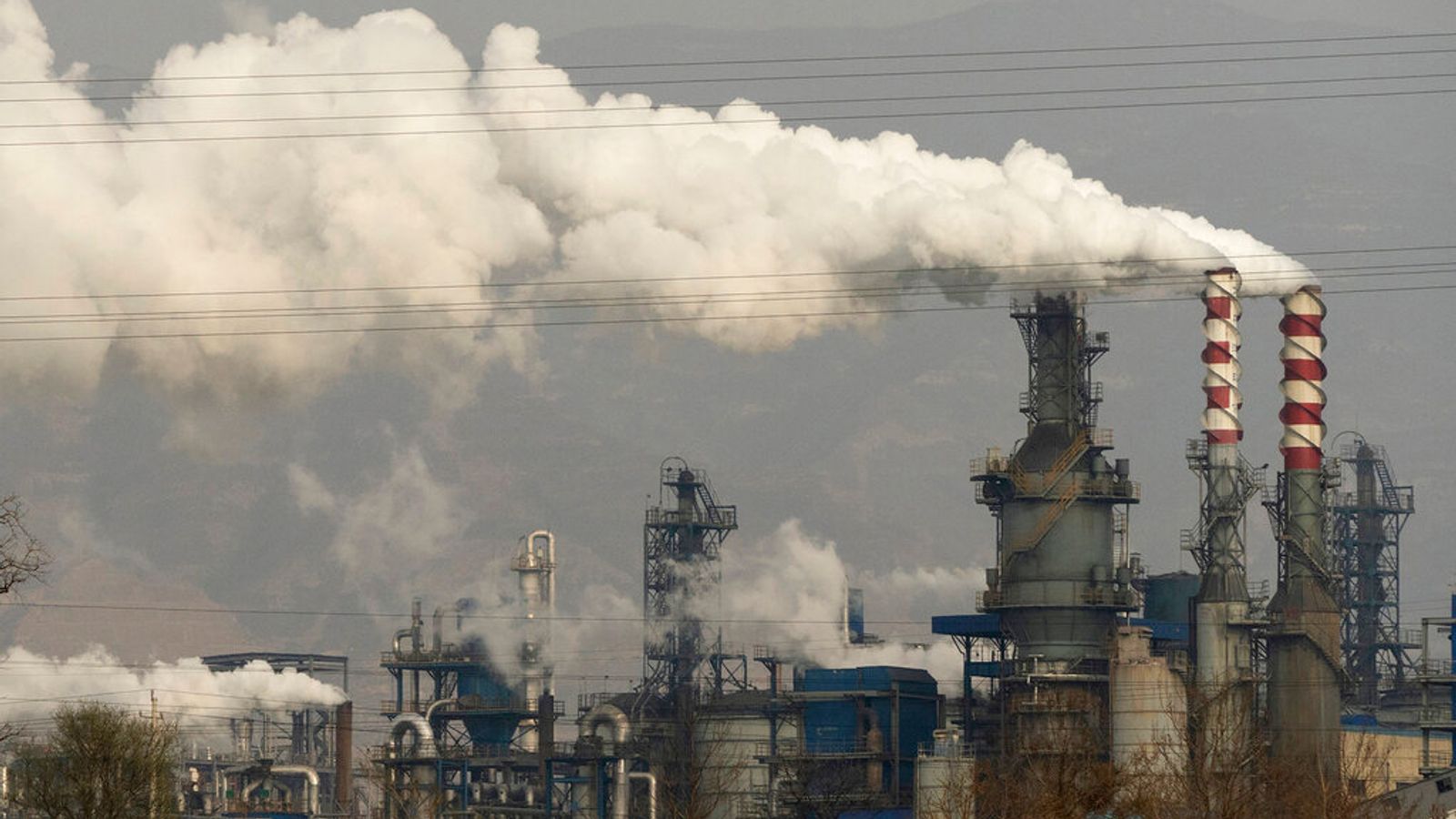World builds more coal power in spite of pollution, pledges and coal end-date
Coal accounts for about a third of all energy installed globally but is the most polluting fossil fuel. All governments have agreed it must be scrapped by 2040 to meet Paris Agreements targets.
Thursday 6 April 2023 11:39, UK
Listen to this article
0:00 / 4:55
1X
BeyondWords
Audio created using AI assistance
FILE – Smoke and steam rise from a coal processing plant in Hejin in central China's Shanxi Province on Nov. 28, 2019. The International Energy Agency on Tuesday, Feb. 21, 2023, accused fossil fuel industries of doing too little to curb methane emissions and undermining global climate goals to limit warming. Pic: AP
Why you can trust Sky News
The world is still developing new coal power, in spite of it being the most polluting fossil fuel, of promises to phase down coal and despite agreements that all coal stations should close by 2040.
These are the damning conclusions of a report by California-based NGO Global Energy Monitor (GEM), which tracks energy projects around the world.
Nearly all newly commissioned coal projects are in China, said GEM, which called China the “glaring exception to the ongoing global decline in coal plant development”.
The world already has around 2,100 gigawatts (GW) of capacity already, while an additional 176 GW of coal capacity is under construction at more than 189 plants, and a further 280 GW is planned.
The global capacity to burn coal grew by 19.5 gigawatts last year, enough to light up about 15 million homes.
That 1% increase comes just as the world should be retiring its coal fleet four and a half times faster to meet climate goals, the report said.
“At this rate, the transition away from existing and new coal isn’t happening fast enough to avoid climate chaos,” said Flora Champenois, the report’s lead author.
MORE ON ENERGY
Wind turbines
‘Damning’ report calls for major National Grid changes to prevent UK missing key wind power targets
Blast furnace at Tata Steel in Port Talbot
Why the British steel industry is on the brink of extinction – or a green resurrection
Xlinks (the UK-Morocco energy project chaired by Sir Dave Lewis)
Clean energy start-up Xlinks wins Abu Dhabi backing for £18bn project
Related Topics:
Energy
Coal
At COP26 in Glasgow in 2021, the biggest climate summit in five years, countries promised to phase down the use of coal to help limit warming to 1.5C above levels before the industrial revolution – a target set out in the Paris Agreement.
The number of coal plants earmarked for closure then doubled, but “coal’s last gasp is not yet in sight” the report said.
All governments have signed off a report by United Nations scientists that concludes all coal power plants must shut by 2040 in order to meet Paris Agreement targets.
Rich countries should close theirs even sooner, by 2030, the IPCC said.
“At a time when developed countries should be helping the rest of the world both end new coal plant construction and begin their coal transitions in earnest, many are instead planning to operate their coal plants at home far beyond the deadlines required by climate science”, said GEM.
In recent years Japan, South Korea, and China and all G20 countries pledged to end public support for new international coal plants, meaning there is essentially no significant international public financier remaining for new coal plants.
But China has ploughed on domestically. In 2021, construction started on 33 GW of new coal power plants, the most since 2016 and almost three times as much as the rest of the world put together.
The superpower is the world’s biggest manufacturer, accounting for around 30% of the global sector, and its emissions per capita put it in 48th in the world.
While China accounted for 92% of all new coal project announcements, countries including India, Indonesia, Turkey and Zimbabwe both added new coal plants and announced new projects.
‘Long term trajectory still towards clean energy’
But “the long term trajectory is still towards clean energy”, said Shantanu Srivastava, an energy analyst with the Institute for Energy Economics and Financial Analysis who is based in New Delhi.
In Europe, where the Russian invasion of Ukraine meant a scramble for alternative energy sources and droughts stifled hydropower, the continent only saw a very minor increase in coal use.
The world’s leading energy agency, the IEA, has said the crisis “turbocharged” the growth of renewable power as countries raced to strengthen energy security.
Cars travel along a snow covered A1 motorway at Alnwick in Northumberland1:54
Play Video – Emergency coal to help power homes
Two of five emergency coal-fired generators will produce electricity in Britain
As gas prices soared, the UK last summer negotiated contingency contracts with a number of coal generators for the winter, extending the life of five units that had been due to retire.
Although they were warmed up during occasional cold spells, only two of the units were eventually used to produce power during a brief period in early March.
With nearly 2,500 plants around the world, coal accounts for about a third of the total amount of energy installation globally. Other fossil fuels, nuclear energy and renewable power make up the rest.
Watch the Daily Climate Show at 3.30pm Monday to Friday, and The Climate Show with Tom Heap on Saturday and Sunday at 3.30pm and 7.30pm.
All on Sky News, on the Sky News website and app, on YouTube and Twitter.
The show investigates how global warming is changing our landscape and highlights solutions to the crisis.
Related Topics
Energy
Coal






























